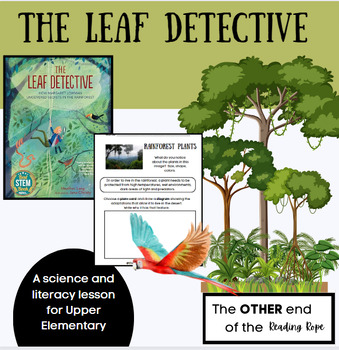Leaf Detective - a 5 E Science and Literacy lesson!
The OTHER end of the Reading Rope
1.1k Followers
Grade Levels
4th - 5th
Resource Type
Standards
CCSSRI.4.1
CCSSRI.4.2
CCSSRI.4.3
NGSS4-LS1-1
Formats Included
- PDF
Pages
28 pages
The OTHER end of the Reading Rope
1.1k Followers
Description
Are you looking for a book to use to integrate with your Life Science lessons when you are teaching about the plant adaptations or habitats? Have you ever thought about who the first person to climb up into the canopy of the rainforest to study it up close? This book is a great supplement to your plant unitor women's history month.
Science Concepts covered in this unit:
-Plant adaptations
- 5 E model lesson
Literacy skills covered:
- Building background
- Vocabulary building
- Critical thinking
- interactive questions
- character traits
- Problem Solution
- sentence building
- interview questions and answers
What's Included?
- Whole class lesson plans for shared reading
- Interactive read-aloud questions
- Vocabulary cards to print and post
- Graphic Organizers
Check out my other comprehension integrated literacy units:
Follow me on Social Media
Total Pages
28 pages
Answer Key
Included
Teaching Duration
3 days
Report this resource to TPT
Reported resources will be reviewed by our team. Report this resource to let us know if this resource violates TPT’s content guidelines.
Standards
to see state-specific standards (only available in the US).
CCSSRI.4.1
Refer to details and examples in a text when explaining what the text says explicitly and when drawing inferences from the text.
CCSSRI.4.2
Determine the main idea of a text and explain how it is supported by key details; summarize the text.
CCSSRI.4.3
Explain events, procedures, ideas, or concepts in a historical, scientific, or technical text, including what happened and why, based on specific information in the text.
NGSS4-LS1-1
Construct an argument that plants and animals have internal and external structures that function to support survival, growth, behavior, and reproduction. Examples of structures could include thorns, stems, roots, colored petals, heart, stomach, lung, brain, and skin. Assessment is limited to macroscopic structures within plant and animal systems.





